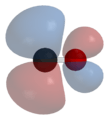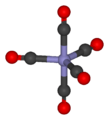Carbon monoxide facts for kids
Carbon monoxide, often called CO, is a gas that you cannot see, smell, or taste. It is made up of one carbon atom and one oxygen atom joined together. This gas forms when things that contain carbon, like wood or natural gas, burn without enough oxygen.
Even though carbon monoxide is very dangerous and toxic, it is also quite useful in modern technology. For example, it helps make iron from iron ore in big ovens called blast furnaces. When heated, the carbon monoxide takes the oxygen away from the iron ore, leaving behind liquid iron metal. The carbon monoxide then turns into carbon dioxide.
Carbon monoxide can also be used as a fuel because it burns easily with a blue flame, turning into carbon dioxide.
How Carbon Monoxide Forms
Carbon monoxide can form by accident when there is not enough air for fuel to burn completely into carbon dioxide. This can happen if a stove or oven's vents are closed too early. It can also happen if a portable cooker is used in a small tent without good air flow (ventilation). Many people have died from carbon monoxide poisoning because of this.
Being poisoned by carbon monoxide can make people feel confused or unwell. It can also cause them to see or hear things that are not there. Small amounts of carbon monoxide are naturally found in coal gas, which is a fuel made by heating coal without air.
Making Carbon Monoxide
Even though it is a poison, carbon monoxide is very important in the chemical industry. So, scientists have found many ways to make it.
One common way is to burn coke (a type of fuel made from coal) at very high temperatures with only a little bit of oxygen. This is how blast furnaces work. The chemical reaction looks like this:
- 2C + O2 → 2CO
Another way to make it is by blowing hot steam through red-hot crushed coke:
- C + H2O → CO + H2
Carbon monoxide can be used as a heating fuel because it burns easily into carbon dioxide. It is also used to make man-made gasoline through a process called the Fischer-Tropsch process.
During World War II, when gasoline was hard to get and mostly used by the military, many cars were changed to run on wood gas. This wood gas was carbon monoxide made by burning wood chips with not enough air. The wood gas was made in a special oven called a generator, which was carried on the car. The carbon monoxide produced was then used as fuel for the car. Even today, some cars still use wood gas as fuel.
Images for kids
See also
 In Spanish: Monóxido de carbono para niños
In Spanish: Monóxido de carbono para niños








